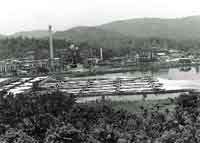Grasim draws flak
 kerala-based Mavoor Gwalior Rayons, the Grasim Industries' pulp and fibre factory owned by the house of Birlas, was pulled up for causing pollution in the area at a public hearing in Kozhikode, Kerala, on October 28. The Kerala state assembly committee for environment and the residents of Mavoor village, district Kozhikode, came down heavily on the factory management. Down To Earth (Vol 6, No 10) had highlighted the poison being spread in the region by the factory in a five-page Special Report. The report had provided evidence of high rates of cancer in the areas adjacent to factory. Residents and local physicians blame the factory for a number of other health problems.
kerala-based Mavoor Gwalior Rayons, the Grasim Industries' pulp and fibre factory owned by the house of Birlas, was pulled up for causing pollution in the area at a public hearing in Kozhikode, Kerala, on October 28. The Kerala state assembly committee for environment and the residents of Mavoor village, district Kozhikode, came down heavily on the factory management. Down To Earth (Vol 6, No 10) had highlighted the poison being spread in the region by the factory in a five-page Special Report. The report had provided evidence of high rates of cancer in the areas adjacent to factory. Residents and local physicians blame the factory for a number of other health problems.
A V Tamarakshan, chairman of the assembly committee, was severe in his criticism of the factory for outraging environmental norms. He pointed out that even if the available data was to be considered, pollution levels around Mavoor and Vazhakkad (the village across the Chaliyar river, on the eastern bank of which the factory is located) appeared to be much graver than in Delhi, one of the most polluted cities of the world. However, the factory management represented by R N Saboo, executive president, Grasim Industries, claimed that the biological oxygen demand ( bod ) and chemical oxygen demand ( cod ) levels of emissions from the factory were 99 per cent under control.
In his effort to present an agreeable picture of the steps taken by the factory to clean up its act, Saboo sought the support of E T Mohammed Basheer, member of the legislative assembly who is also a member of the committee. However, Basheer was also critical of the factory's role in polluting the region. He read out excerpts from the unpublished expert committee report headed by a scientist of the Central Pollution Control Board. The committee has blamed the factory for unauthorised emissions through "at least five discharge points', among other things. The company was not practising "as basic a thing as sludge management', Basheer quoted from the report of the central committee.
On Saboo's pointing out that "companies should be run on economics and not charity' and that the Mavoor unit would not be viable if further pollution control measures are adopted, Tamarakshan hinted at the profits earned by Grasim Industries over the years. He indicated that the company had made profits of Rs 40 crore, 33 crore and 9 crore in the last three years respectively. The company has also been the beneficiary of numerous sops from the state government, including raw materials such as bamboo at heavily subsidised rates.
The management's claim that technology to remove the noxious colour of the effluent was not available also came in for flak. Basheer quoted the central expert committee, which had pointed out that "fool-proof, cost-effective and easily accessible' technologies were available for discolouring effluents. Members said the claim that a large company such as Grasim was unaware of developments in technology did not stand, especially as small environmental groups in the locality had the relevant information. Representatives of the Kerala Pollution Control Board at the meeting also disputed the company's claim of meeting the standards with regard to bod and cod .
